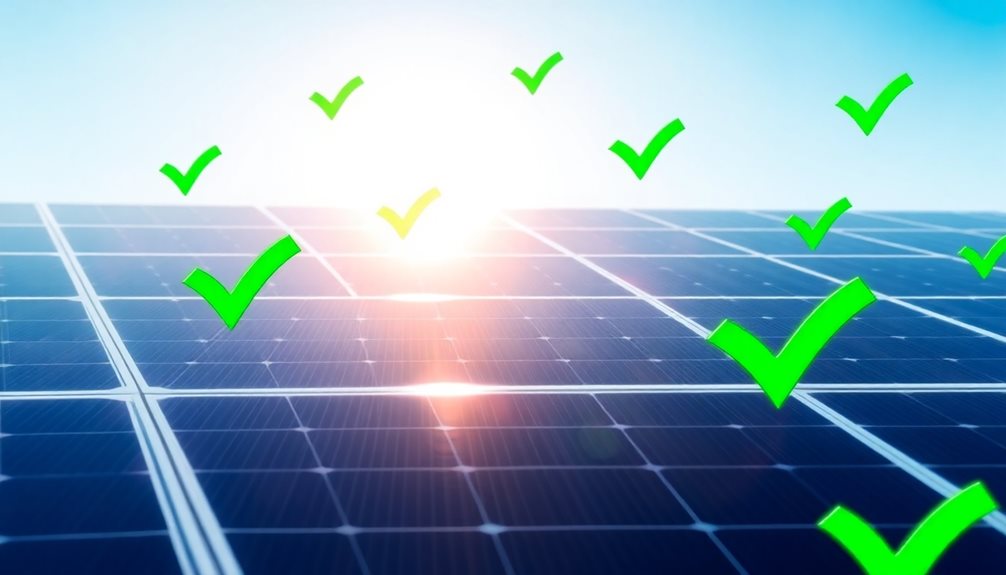The solar panel installation process for homeowners begins with an essential site assessment, where factors such as structural integrity, energy consumption, and shading are meticulously evaluated using visual inspections and digital tools. Following this, a tailored solar solution is developed, considering roof suitability, orientation, and local weather data to ensure ideal energy generation and cost efficiency. Securing necessary permits, such as building and electrical, is pivotal to guarantee proper installation. The installation day involves precise panel placement and electrical setup, followed by rigorous testing and quality assurance measures. Subsequent stages involve utility interconnection and inspection to confirm everything is in order.
Expert Highlights
- Begin with thorough site assessment to identify challenges like shading and structural integrity impacting solar installation.
- Evaluate solar potential through factors like roof orientation, tilt, energy needs, and use of digital tools for insights.
- Design the system by calculating power requirements and selecting compatible solar components for optimal performance.
- Obtain necessary permits and authorizations, including building and electrical permits for safe solar installation.
- Conduct pre-installation checks, mount the system, and perform equipment testing to ensure safety and efficiency.
Site Assessment and Planning
Effective site assessment is paramount in the installation of solar panels for homeowners, as it lays the foundation for a successful solar energy project. This involves identifying potential challenges like structural integrity, energy consumption, and site accessibility. Accurately evaluating the solar potential using both visual inspection and digital tools ensures optimal placement and performance of the solar installation. Analyzing solar access and shading guarantees ideal energy production. By evaluating these factors, a customized solar solution is developed, enhancing cost efficiency, risk mitigation, and long-term performance.
Evaluating Solar Potential
Understanding the solar potential of a home involves an exhaustive examination of various factors that influence energy generation efficiency. This process includes evaluating roof suitability by analyzing orientation, tilt, and shading, ensuring it faces south with a 15-40 degree inclination for perfect exposure. It's essential to assess if there are any obstructions that may cause significant shading on the rooftop, as this can considerably reduce the solar energy system's efficiency. Tools like Project Sunroof offer detailed insights.
Additionally, assessing energy needs through audits helps gauge financial benefits, while local climate guides performance expectations.
Designing the Solar System
In designing a solar system for residential application, a meticulous and dynamic process is undertaken to safeguard ideal performance and efficiency. Essential steps encompass power requirement evaluation through load calculations, evaluating roof space and orientation, and utilizing software for energy output predictions. Integral to this is selecting compatible components like panels, inverters, and batteries while accounting for shading, ensuring alignment with energy consumption patterns. This process also incorporates factors such as the local weather data and utility rates, which are crucial for accurate energy modeling and setting realistic expectations for homeowners.
Permits and Authorizations
Traversing the domain of permits and authorizations is a critical step in the installation of residential solar panels, ensuring compliance with local and national regulations. Homeowners must secure permits, such as building, electrical, and dedicated solar photovoltaic, to proceed with installations. The application process, often facilitated by installers, includes submitting detailed plans and engineering calculations, with approval times spanning from weeks to months, depending on municipal efficiency. Solar permits are essential to ensure safe and properly installed solar systems.
Installation Day Process
The culmination of a homeowner's journey towards sustainable energy comes to life on installation day, a well-coordinated sequence of events that initiates with thorough preparation.
The process begins with pre-installation checks and on-site preparation, followed by mounting the racking system. Solar panels are then carefully placed and connected, while attention is given to electrical setup, securing brackets, and precise panel orientation to optimize power generation. With installations increasing annually by 25%, more homeowners are recognizing the long-term benefits of going solar and engaging in sustainable energy solutions.
Equipment Testing and Quality
Before the solar panels can be turned into reliable energy sources, rigorous equipment testing and quality assurances are essential to guarantee ideal performance and safety. This process encompasses visual inspections for damage, shade analysis, and monitoring systems for real-time data.
Advanced techniques such as I-V curve testing and infrared imaging provide a thorough evaluation, ensuring each panel functions correctly, free of defects, and is ready for efficient energy production.
Inspection and Approval
A critical component of guaranteeing a successful solar panel installation is the multifaceted inspection and approval process. This involves pre-installation site surveys, compliance inspections, and final certifications. Each step guarantees system safety, efficiency, and adherence to local codes. Detailed attention to structural integrity, installation fidelity, and documentation certifies a seamless integration of solar technology into homes.
| Inspection Stage |
Key Activities |
Duration (Days) |
| Pre-Installation Inspection |
Site survey, location assessment, readiness evaluation |
1 to 7 |
| Installation Inspection |
Compliance verification, physical inspection, checklist completion |
10 to 15 |
| Structural Inspection |
Integrity review, attachment check, manufacturer compliance |
— |
| Final Approval |
Compliance check, safety labeling, certification |
— |
These robust procedures foster homeowners' confidence, fostering a strong sense of community.
Interconnection With Utility
Successful solar integration relies on the seamless connectivity between home systems and existing power infrastructure, known as utility interconnection. Homeowners must submit a detailed interconnection application, including electrical plans, to the utility company.
This application undergoes thorough review for safety and grid compatibility, and approval is mandatory. Compliance with design, safety codes, and utility requirements guarantees efficient energy transfer, providing community members with both environmental benefits and financial incentives.
Understanding Costs and Financing
Traversing the costs and financing of solar panel installation can initially seem formidable, yet comprehending these elements is essential for homeowners seeking to harness solar energy efficiently.
Installation costs can span from $3,500 to $55,000, influenced by factors such as panel type and system size. Financing options, from cash to contractor loans, offer varied terms.
Employ tax credits to significantly reduce expenses. Choose plans that balance long-term savings and affordability.
Post-Installation Care
Effective post-installation care of solar panels guarantees ideal energy production and longevity of the system. Regular cleaning, inspection, and monitoring are essential, with maintenance recommendations adaptable to climate and environmental conditions. Safety and proper methods enhance performance while protecting investment. Consider the table below for best practices:
| Frequency |
Method |
| 2-4 times/year |
Soft brush, mild soap |
| Yearly |
Garden hose spray |
| Snow conditions |
Lukewarm water, squeegee |
| Inspection |
Monitor app, professional |
FAQ
How Do I Find a Reliable Solar Contractor?
To find a reliable solar contractor, verify credentials, including certifications and union affiliations. Request project portfolios and references, guarantee compliance with safety and insurance standards, and compare detailed quotes from multiple contractors for a well-informed decision.
What Are the Environmental Benefits of Solar Panels?
Solar panels offer remarkable environmental benefits, including significant reductions in carbon emissions, improved air quality, and conservation of water resources. They also minimize reliance on fossil fuels, fostering ecosystem preservation and promoting a sustainable, inclusive future.
Can Solar Panels Work During Power Outages?
Solar panels alone do not operate during power outages as they typically require connection to the grid. However, incorporating battery storage or specialized inverters can provide power continuity, ensuring reliability and fostering a sense of security and independence.
How Long Does the Installation Process Impact My Daily Routine?
The solar panel installation process impacts daily routines minimally, primarily through brief site assessments and design visits. Installation itself causes minor disruptions, with quick installations typically completed in 6 hours to 3 days, ensuring maximum convenience.
What Are the Visual Impacts of Solar Panels on My Home?
The visual impacts of solar panels are minimal when professionally installed. Sleek designs, including custom SolarSkin overlays and photovoltaic slates, guarantee integration with home aesthetics, enhancing curb appeal while embracing modern, eco-friendly values, which often increases property attractiveness.
Experts Final Thoughts
The thorough understanding of the solar panel installation process













